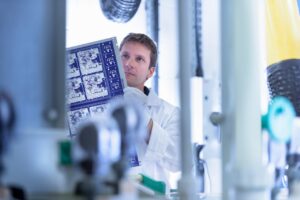[vc_row][vc_column][vc_column_text]
Science Human Body
A cell is the smallest part or unit of the body. The human body is made up of millions of cells. Millions of cells together make a tissue, many different tissues together form an organ, and certain organs together form a particular organ system.

The human body is made up of many organs that do different kinds of work. These are known as their functions. Based on their location, organs can be of two types: external and internal.
Some organs can be seen with our eyes. They are called external organs. Our sense organs such as eyes, nose, ears, and skin are examples of external organs.
The organs which cannot be seen with our eyes, as they are located inside our body, are called internal organs. These
include the brain, lungs, heart, stomach, liver, etc. Internal organs are generally soft and delicate. Some internal organs, such as the brain, lungs, and heart are protected by bones.
INTERNAL ORGANS

Let us learn about the location and function of some important internal organs:
- Brain: It is located inside the head and is protected by the skull. It helps us to think. It sends messages to different parts of the body and tells them what to do.
- Heart: It lies on the left side of the chest cavity. It pumps blood to various organs of the body. Blood is carried through blood vessels.
3. Stomach and intestines:
- We eat food through our mouths. It passes through the food pipe, then reaches the stomach.
- From the stomach, it further enters the small intestine, and then the large intestine.
- Stomach and the intestines are located inside our abdomen and form a part of our digestive system.
- These organs break down food into simpler substances (with the help of digestive fluid) that our body can use. This process is called digestion.
4. Kidneys: There are two bean-shaped kidneys inside our abdomen. They filter the blood and remove wastes from it. These wastes are then removed from the body, in the form of urine.
5. Liver: is the largest gland in the human body. It is located in the upper part of the abdomen, towards the right side of the body. It has many roles,
but the three important ones are as follows:
i. It produces an important digestive juice called bile juice that helps in digestion.
ii. Liver cleans our blood.
iii. Stores energy in the form of glycogen.
6. Bones: give shape to our body: 206 bones in our body form the skeleton. Bones protect soft organs, for example, the skull gives protection to the brain and the ribcage protects.
At birth, an infant’s body is made up of around
300 bones. Some bones fuse together as we grow
up. Because of this, an adult has 206 bones.
Fact File
RESPIRATORY SYSTEM
The respiratory system consists of a group of organs and parts that help us breathe. The nose, windpipe, and a pair of lungs are the organs of our respiratory system. Nose We breathe in and breathe out
through our noses. Breathing in is called inhalation. Breathing out is called exhalation. Tiny hair and mucus (a sticky substance) are present inside our nose. The hair filter the air we breathe in and thus prevent dust and germs from entering our lungs. Mucus also traps dust and germs.
Windpipe From the nose, the air passes through the windpipe and enters the lungs.
Lungs are located inside the chest cavity, one on each side. In the lungs, oxygen is absorbed from the inhaled air and carbon dioxide is removed from the lungs as exhaled air. The air that we breathe in has more oxygen, while the air that we breathe out has more carbon dioxide.
How does breathing take place?
A dome-shaped sheet of muscle called the diaphragm is present below the lungs.
Step 1: When the diaphragm contracts and moves downwards, the size of the chest cavity increases. Thus, the air from outside rushes into the lungs through the nose. This process is called inhalation. Then, oxygen (in the air) passes from the lungs into the blood and is further carried to all parts of the body.
Step 2: Carbon dioxide from different body parts is passed into the blood, and gets carried to the lungs through the heart. Then, the diaphragm relaxes and pushes upwards, thus the size of the chest cavity decreases. So, the air (containing carbon dioxide) from the lungs goes out through the nose. This process is called exhalation.
Difference Between Inhalation and Exhalation
| Inhalation | Exhalation |
| 1) Air from outside (containing oxygen) rushes into the lungs through the nose. | 1) Air from the lungs (containing carbon dioxide) goes out through |
| 2) Size of the chest cavity increases. | 2) The size of the chest cavity decreases. |
| 3) Diaphragm contracts and moves downwards. | 3) The diaphragm relaxes and pushes upwards. |
👇 Hhare Hhis Link
👉 Link : https://lakshyaiasacademy.com/science-human-body/
Get More Notes
This article is a given for all the students who are preparing for the competitive exams like MPSC UPSC, This article is given by Lakshya Academy which is one of the best IAS coaching in Mumbai.
[/vc_column_text][/vc_column][/vc_row]











